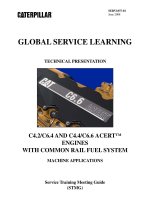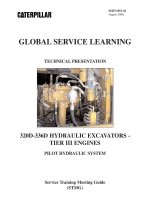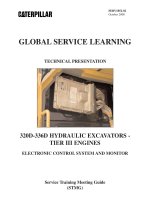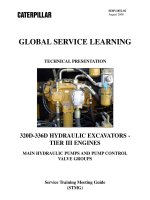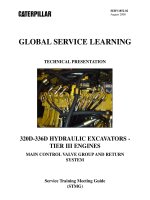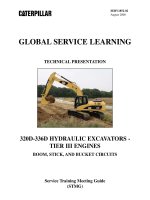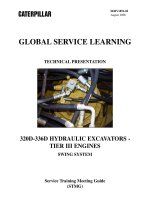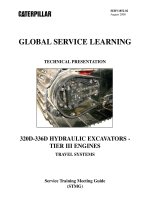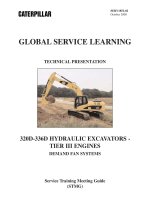Hệ thống thủy lực máy đào CATERPILLAR SERIE D - P6
Bạn đang xem bản rút gọn của tài liệu. Xem và tải ngay bản đầy đủ của tài liệu tại đây (555.45 KB, 29 trang )
SERV1852-02
August 2008
320D-336D HYDRAULIC EXCAVATORS -
TIER III ENGINES
MAIN CONTROL VALVE GROUP AND RETURN
SYSTEM
Service Training Meeting Guide
(STMG)
GLOBAL SERVICE LEARNING
TECHNICAL PRESENTATION
320D-336D HYDRAULIC EXCAVATORS -
TIER III ENGINES
MAIN CONTROL VALVE GROUP AND RETURN
SYSTEM
AUDIENCE
Level II - Service personnel who understand the principles of machine systems operation,
diagnostic equipment, and procedures for testing and adjusting.
CONTENT
This presentation provides an introduction and describes the components and systems operation
of the 320D-336D main control valve group and return system. Additional presentations will
cover the machine walkaround, engines, pilot system, pumps and controls, swing system, travel
system, and tool control systems in more detail. This presentation may be used for self-paced
and self-directed training.
OBJECTIVES
After learning the information in this presentation, the technician will be able to:
1. identify the components and explain the operation of the 320D-336D hydraulic
excavators main control valve group and return system, and
2. diagnose problems in the main control valve group and return system.
REFERENCES
320D Hydraulic Excavator Specalog AEHQ5856
323D L and 323D LN Hydraulic Excavators HEHH3327
324D Hydraulic Excavator Specalog AEHQ5663
325D Hydraulic Excavator Specalog AEHQ5665
328D Hydraulic Excavator Specalog AEHQ5706
330D Hydraulic Excavator Specalog AEHQ5667
Machine Monitoring System - Systems Operation RENR8068
Self-study "300D Series Hydraulic Excavators, 345C Hydraulic Excavator,
and 365C & 385C Large Hydraulic Excavators SERV7032
iTIM " '300C' Series Hydraulic Excavators-Electronic Control Systems" SERV2693
iTIM "325C Hydraulic Excavators-Hydraulic Systems" SERV2701
325D Hydraulic Schematic KENR6157
Estimated Time: 1 Hour
Illustrations: 22
Form: SERV1852-02
Date: August 2008
© 2008 Caterpillar
TABLE OF CONTENTS
INTRODUCTION ........................................................................................................................5
Main Control Valve Group .....................................................................................................6
Additional Components ......................................................................................................15
Return Hydraulic System......................................................................................................24
CONCLUSION ..........................................................................................................................29
SERV1852-02 - 3 - Text Reference
08/08 Main Control Valve Group
PREREQUISITES
"Fundamentals of Mobile Hydraulics Self Study Course" TEMV3002
"Fundamentals of Power Train Self Study Course" TEMV3003
"Fundamentals of Electrical Systems Self Study Course" TEMV3004
"Fundamentals of Engines Self Study Course" TEMV3001
NOTES
Nomenclature Change: During the fourth quarter of 2008, the 325D and 330D
nomenclature changed. The 325D became the 329D and the 330D became the 336D for
most arrangements.
The exceptions are as follows:
- The nomenclature for the 325D MH and 330D MH did not change.
- The nomenclature for the 325D FM and 330D FM did not change.
- The 325D HD HW did not change into 329D HD HW. This model is being discontinued.
However, the 330D HD HW changed to the 336D HD HW.
SERV1852-02 - 4 - Text Reference
08/08 Main Control Valve Group
1
INTRODUCTION
The main hydraulic system is a Negative Flow Control (NFC) System that supplies hydraulic
power at high pressures and high flow rates to perform work. Two main hydraulic pumps
supply oil to the main control valve group. The individual hydraulic circuits are controlled by
valves in the the main control valve group.
The main hydraulic system supplies the following circuits:
- swing
- stick
- left and right travel
- bucket
- auxiliary
- boom
Oil returning from these circuits flows back to through the return system to the hydraulic tank.
SERV1852-02 - 5 - Text Reference
08/08 Main Control Valve Group
Stick Cylinder
Bucket Cylinder Boom Cylinders
Swing Motor Travel Motors
Pilot
Control
Valves
Priority
Valves
Main
Hydraulic
Pumps
M
Pilot
Pump
Fan
Motor
Pilot Manifold
Main Control Valve Group
Fan
Pump
Tank
The Fan Motor and Pump are only used on the 330D and 336D
MAIN CONTROL VALVE GROUP AND RETURN SYSTEM
2
SERV1852-02 - 6 - Text Reference
08/08 Main Control Valve Group
Main Control Valve Group
The main control valve group is located in the center of the upper structure of the machine.
The main control valve group receives pilot oil signals from the operator controls in the cab.
Each pilot signal then causes the appropriate control valve to shift in the correct direction.
When a control valve shifts, oil flows from the main hydraulic pumps to the appropriate
hydraulic cylinder or hydraulic motor to perform work. The medium 320D-336D main control
valve is similar to the medium 300C Series valve. The components shown above include:
- right side NFC relief valve (1) - main relief valve (8)
- stick 2 (2) - left travel (9)
- boom 1 (3) - swing (10)
- bucket (4) - stick 1 (11)
- attachment (5) - boom 2 (12)
- right travel (6) - auxiliary valve for tool control (13)
- straight travel valve (7)
1
2
3
4
5
6
7
8
9
10
11
12
13
3
SERV1852-02 - 7 - Text Reference
08/08 Main Control Valve Group
The above illustration shows a cross-sectional view of the main control valve group as viewed
from the rear of the machine, facing forward.
The main control valve group is constructed of two valve blocks that are connected together.
The drive pump provides oil flow for the right side of the main control valve group. The idle
pump provides oil flow for the left side of the main control valve group.
The pilot-operated, open-center control valves are of parallel feeder design. Because the main
control valve group uses the open-center portion of the control valve to generate a NFC signal
for the pumps, the oil must have another path to deliver oil to the work ports. This is
accomplished through a parallel feeder path. A parallel feeder path runs parallel to the
open-center path and supplies oil to the work port of each implement valve.
When all of the joysticks and pedals are in the NEUTRAL position, drive pump oil flows
through the right pump inlet port to the right half of the main control valve group. In the right
half of the main control valve group the oil flows two directions; to the center bypass passages,
and to the parallel feeder passages.
Stick
2
Boom
1
Attach
Right
Travel
Left
Travel
Swing
Stick
1
Boom
2
NFC
Orifice
Return
Passage
Center
Bypass
Passage
Return
Port
Parallel
Feeder
Passage
Drive Pump
Inlet Port
Return
Passage
Center
Bypass
Passage
Idler Pump
Inlet Port
NFC Orifice
Straight Travel
Valve
Bucket
NFC Signal
Pressure for
Drive Pump
NFC Signal
Pressure for
Idler Pump
MAIN CONTROL VALVE
NEUTRAL
The oil in the center bypass passages flows in series through the center bypass passage of the
travel, the attachment, the bucket, the boom 1, and the stick 2 valves to the NFC control orifice.
The NFC control orifice allows the oil to return to tank with a restriction.
This restriction provides an NFC signal pressure which is sent to the drive pump to maintain
the drive pump at minimum angle when the control valves are all in NEUTRAL. In
NEUTRAL this NFC signal is the same as the supply pressure.
The oil in the parallel feeder passage flows in parallel to the attachment, the bucket, the
boom 1, and the stick 2 valves. Since all of the valves are in NEUTRAL, the oil in the parallel
feeder is blocked by the valve spools, and all oil must flow through the center bypass to the
tank.
The oil from the idler pump flows similarly through the left half of the control valve when all
valves are in NEUTRAL.
SERV1852-02 - 8 - Text Reference
08/08 Main Control Valve Group
4
The schematic for the main control valve group is shown above. All of the circuit control
valves are in NEUTRAL.
Oil from the idler pump and drive pumps flows to the straight travel valve. From the straight
travel valve, the supply oils flow through the center envelop of all of the control valves in
NEUTRAL. Some of the supply oil also enters the parallel feeder passages.
Since the control valves are in NEUTRAL the supply oil flows through all of the valves to the
tank. Some of this oil becomes NFC signal oil and destrokes the two pumps.
SERV1852-02 - 9 - Text Reference
08/08 Main Control Valve Group
Swing
PRV
M
Bucket
Valve
Boom 2
Stick 1
Stick Regen
Valve
Stick Unloading
Valve
Swing
Left
Travel
Straight
Travel
Main
Relief
Variable Swing
Priority Valve
Straight Travel
Solenoid
Attachment
Valve
Right
Travel
Line Relief
and Makeup
Valve
Boom 1
Stick 2
Boom Regen
Valve
NFC
Relief
Valve
NFC
Relief
Valve
Drive Pump
Idler Pump
Pilot Pump
NFC Signal
Line (Idler Pump)
NFC Signal
Line (Drive Pump)
NFC
Orifice
Pilot Oil
Heavy Lift
Solenoid
MAIN CONTROL VALVE GROUP
NEGATIVE FLOW CONTROL OPERATION - NEUTRAL
Drift
Reduction
Valve
Parallel Feeder
Passage
Parallel Feeder
Passage
5
Control valve operation is similar for all of the valves in the main control valve group. The
following explanation is for the basic operation of all of the valves in the main control valve
group. The variations in each individual valve will be discussed later in more detail.
The control valve above is shown in NEUTRAL.
The valve spool is spring centered in NEUTRAL when there is no pilot oil pressure directed to
shift the spool. In the NEUTRAL position, the spool blocks the oil in Port A and Port B.
Oil flows from the pump to the parallel feeder passage. The load check valve is seated because
of the pressure differential and spring force present on the load check valve.
In NEUTRAL, the valve spool allows oil to flow unrestricted through the center bypass
passage, which directs a high NFC signal pressure to the pump control valve. The high NFC
signal pressure causes the pump to destroke to a standby condition.
SERV1852-02 - 10 - Text Reference
08/08 Main Control Valve Group
Parallel
Feeder
Passage
Center
Bypass
Passage
Load
Check
Valve
CONTROL VALVE
NEUTRAL
Port A Port B
Control
Spool
Line Relief
and Makeup
Valve
Pilot
Valve
Pilot
Valve
Load
Check
Valve
Centering
Spring
Full NFC
Signal
6
SERV1852-02 - 11 - Text Reference
08/08 Main Control Valve Group
Pilot
Valve
Center Bypass
Passage
Parallel Feeder
Passage
Load Check
Valve
Port A Port B
Control
Spool
Pilot
Valve
CONTROL VALVE
INITIAL MOVEMENT
Reduced
NFC Signal
When the operator begins to move the joystick to shift the control valve, metered pilot pressure
causes the control valve to shift slightly.
With the spool initially shifted, the center bypass passage begins to close. This movement
causes NFC signal pressure to decrease, which causes the pump to begin to upstroke.
The movement of the spool partially opens a passage allowing the oil from Port B to work with
the load check valve spring to keep the load check valve seated.
The load check valve prevents unexpected implement movements when a joystick is initially
activated at a low pump supply pressure. The load check valve also prevents oil loss from a
high pressure circuit to a lower pressure circuit.
The combined force of the work port pressure from Port B and the force of the spring above the
load check is greater than the pump supply pressure, causing the load check valve to remain
closed.
